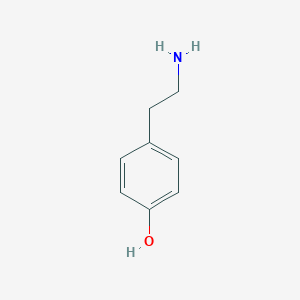| General Information of MET (ID: META00110) |
| Name |
Tyramine
|
| Synonyms |
Click to Show/Hide Synonyms of This Metabolite
2-(p-Hydroxyphenyl)ethylamine; 4 Hydroxyphenethylamine; 4-(2-Aminoethyl)-phenol; 4-(2-Aminoethyl)-phenol(thyramin); 4-(2-Aminoethyl)phenol; 4-Hydroxy-benzeneethanamine; 4-Hydroxy-beta-phenylethylamine; 4-Hydroxyphenethylamine; 4-Hydroxyphenylethylamine; Systogene; Tenosin-wirkstoff; Tocosine; Tyramin; Tyramine base; Tyrosamine; Uteramine; a-(4-Hydroxyphenyl)-b-aminoethane; alpha-(4-Hydroxyphenyl)-beta-aminoethane; beta-(4-Hydroxyphenyl)ethylamine; p-(2-Aminoethyl)-phenol; p-(2-Aminoethyl)phenol; p-Hydroxy-b-phenethylamine; p-Hydroxy-b-phenylethylamine; p-Hydroxy-beta-phenethylamine; p-Hydroxy-beta-phenylethylamine; p-Hydroxyphenethylamine; p-Hydroxyphenylethylamine; p-Tyramine; p-beta-Aminoethylphenol; para-Tyramine
|
| Source |
Endogenous;Escherichia Coli Metabolite;Yeast Metabolite;Food;Drug;Toxins/Pollutant;Food additives;TCM Ingredients;Microbial
|
| Structure Type |
Phenethylamines (Click to Show/Hide the Complete Structure Type Hierarchy)
Benzenoids
Benzene and substituted derivatives
Phenethylamines
|
| PubChem CID |
|
| HMDB ID |
|
| Formula |
C8H11NO
|
| Structure |
<iframe style="width: 300px; height: 300px;" frameborder="0" src="https://embed.molview.org/v1/?mode=balls&cid=5610"></iframe>
|
 |
|
3D MOL
|
2D MOL
|
|
Click to Show/Hide the Molecular/Functional Data (External Links/Property/Function) of This Metabolite
|
| KEGG ID |
|
| DrugBank ID |
|
| ChEBI ID |
|
| FooDB ID |
|
| ChemSpider ID |
|
| METLIN ID |
|
| Physicochemical Properties |
Molecular Weight |
137.18 |
Topological Polar Surface Area |
46.2 |
| XlogP |
1.1 |
Complexity |
87.3 |
| Heavy Atom Count |
10 |
Rotatable Bond Count |
2 |
| Hydrogen Bond Donor Count |
2 |
Hydrogen Bond Acceptor Count |
2 |
| Function |
Tyramine is a monoamine compound derived from the amino acid tyrosine. Tyramine is metabolized by the enzyme monoamine oxidase. In foods, it is often produced by the decarboxylation of tyrosine during fermentation or decay. Foods containing considerable amounts of tyramine include fish, chocolate, alcoholic beverages, cheese, soy sauce, sauerkraut, and processed meat. A large dietary intake of tyramine can cause an increase in systolic blood pressure of 30 mmHg or more. Tyramine acts as a neurotransmitter via a G protein-coupled receptor with high affinity for tyramine called TA1. The TA1 receptor is found in the brain as well as peripheral tissues including the kidney. An indirect sympathomimetic, Tyramine can also serve as a substrate for adrenergic uptake systems and monoamine oxidase so it prolongs the actions of adrenergic transmitters. It also provokes transmitter release from adrenergic terminals. Tyramine is a biomarker for the consumption of cheese
|
|
Regulatory Network
|
|
|
|
|
|
|
|
|
 click to show the details of this protein
click to show the details of this protein
 click to show the details of experiment for validating this pair
click to show the details of experiment for validating this pair
 click to show the details of experiment for validating this pair
click to show the details of experiment for validating this pair
 click to show the details of this protein
click to show the details of this protein
 click to show the details of experiment for validating this pair
click to show the details of experiment for validating this pair

